2013 Arctic Cat M800 HCR vs. 2013 Polaris RMK 800 Assault

Two Minnesota farmland neighbors battle on the mountains
What is it you want to dominate, mountain, powder, the other rider, fear or the podium? I can think of two snowmobiles that can give you the weaponry to knock ‘em down: the 2013 Polaris RMK Assault and the 2013 Arctic Cat ProClimb HCR (for Hill Climb Racer).
Engine Type:Horizontal In-line
Cylinders:2
Engine Stroke:2-Stroke
Valve Configuration:Reed Valve
Displacement:794 / 48.4
Starter:Pull
Turbocharged:No
View Full SpecWe dissect these two sleds for two reasons; they share the same chassis with their other deep-powder siblings. The Polaris RMK Assault has the DNA from the 800 RMK Pro and 800 RMK standard. The Arctic Cat shares DNA with the ProClimb M8 Sno Pro, Sno Pro LE and M8 standard. They are triplets with different personalities.
You may have read our article on Ski-Doo’s Freeride. We separated it out from this one-versus-one article for a single reason: it has its own chassis, the REV-XP RS. This chassis is unlike its deep-powder brother, the XM Summit X and SP. Yet, is the Freeride capable to put a blister on a mountain like the HCR and Assault? You bet! Can these three snowmobiles – Freeride, Assault and HCR – hustle up big air shows in the backcountry and dominate on a hillclimb racecourse? Absolutely! But the fact is, the Freeride has its own non-XM Summit chassis, therefore we believe the Assault and HCR build a good case for a comparison.
RMK Assault
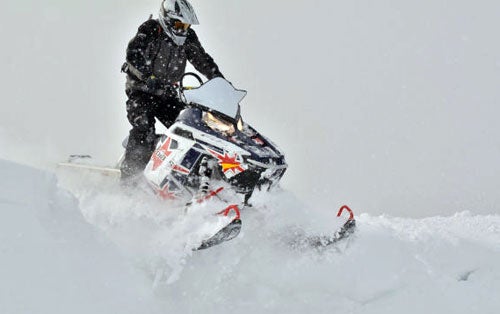 The RMK Assault, in Spring-buy retro colors, is a wild looking snowmobile.
The RMK Assault, in Spring-buy retro colors, is a wild looking snowmobile.First, you should know Polaris builds the RMK Assault without its Quick Drive Low Inertia Drive System; that is reserved for the RMK Pro. But, this does not make RMK Assault un-cool. The Assault retains the sturdy and trusted chaincase system. Polaris engineers told Snowmobile.com the chaincase is needed to take big rock impacts when the track drivers hit granite objects. Such wallops often force the track to stop suddenly and momentarily, then spool back up under full throttle. The sudden halt to track speed followed by nano-second acceleration from the impact drove the engineers to call on trusty steel-and-gears to handle the job.
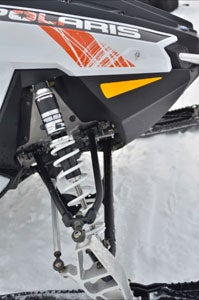 The RMK Assault’s A-arms and Walker Evans piggyback shock give a hillclimb racer and cliff dropper the best the company has to offer.
The RMK Assault’s A-arms and Walker Evans piggyback shock give a hillclimb racer and cliff dropper the best the company has to offer.Not only is the Assault designed for backcounty drops, whips and stupid people tricks, it is built for the rock gardens that surface on many Rocky Mountain Snowmobile Hillclimb Association (RMSHA) events. It is a race sled. Born and bred for such.
Like the RMK Pro, the Assault uses Polaris’ own Liberty CleanFire 800 twin.
The track on the Assault is a 2.125-inch competition track of which its durometer is stiff, giving it strength to be robust for hillclimb competition abuse and backcountry use. Track length is 155, no other lengths are available. The stiff track can take on hardpacked snow, however in deep powder conditions, the track trenched in; be feathery light on the throttle when playing in bottomless snow. Also, when descending a hill on hardpacked snow, the track’s braking ability is not as sweet as the Pro’s track.
Competition tracks are just that. They are made for hard, crappy snow and rocks.
To absorb impacts, the Assault’s front and rear suspension is all about taking the hits. The front end runs a wider ski-stance (41.5 inches to 43.5-inches) than the RMK Pro. This helps the pilot lay down tight switches and quick times around the gates when ascending a competition-hill. Specifically, the Assault has a competition-specific Pro Ride front end with stiff (stiffer than the Pro) sprung and valved, compression adjustable Walker Evans piggyback shocks. The front end does not use a swaybar (the stiff shocks and wide front end keep the skis planted). The rear skid is Polaris’ RMK coil-over with high-end Walker Evans Needle shocks.
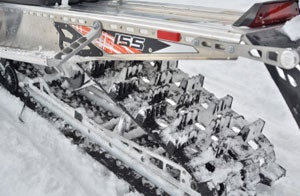 The block track that comes standard on the RMK Assault is designed for rocks, hard snow, and the gallantry to help a racer crest Snow King Mountain.
The block track that comes standard on the RMK Assault is designed for rocks, hard snow, and the gallantry to help a racer crest Snow King Mountain.Like the really light RMK Pro, the 2013 RMK Assault comes with new-for-this-model year PowderTrac running boards, carbon fiber over structure and Pro Lite seat. Even with the chaincase, the RMK Assault comes in at a welterweight 435 pounds. That’s good.
Other standard features are Pro Taper handlebars and PERC – Polaris Electronic Reverse Control – and lightweight brake rotor and Cyclone master cylinder.
The RMK Assault is competition-made, that is true. However, we do see these on the mountain where the owner swapped out the competition track with the RMK Pro track, the Series 5.1. By way of information, the 5.1 track was a Spring-buy option; a dealer may have a 2013 RMK Assault with powder track.
ProClimb HCR
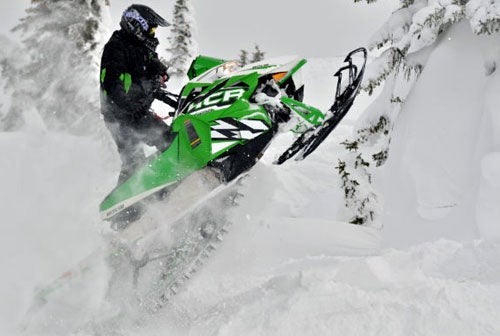 With its cranked-up Suzuki 800 twin H.O. power, the HCR is a fuel injected mountain cat, climbing trees and drifts with sure footedness.
With its cranked-up Suzuki 800 twin H.O. power, the HCR is a fuel injected mountain cat, climbing trees and drifts with sure footedness.Arctic Cat believes that competition hillclimbs are green and checkered flags too, are green. The HCR has a wicked history of stomping out podiums at such famous hillclimbs as the Jackson Hole (Wyoming) World Championship Hillclimbs. The HCR shares many components from its brother-from-the-same-mother, the M8 Sno Pro, namely the 800 Suzuki batteryless electronic fuel injection two-stroke twin, ProClimb chassis, electronic reverse and telescoping handlebars, to name a few.
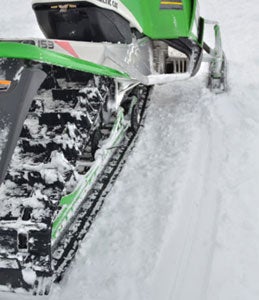 The track on the HCR had lugs towering up to 2.6-inches and a stiffer durometer to keep the lugs from folding when encountering hard snow and rocks.
The track on the HCR had lugs towering up to 2.6-inches and a stiffer durometer to keep the lugs from folding when encountering hard snow and rocks.Like the RMK Assault, the HCR’s ski stance is spun out to be wider than the deep powder M8 Sno Pro, an adjustable 42 to 43 inches. The HCR 6-inch deep keel ski works well for hardpack conditions when carving a tight line around a gate at the RMSHA event. The track is 15” x 153” with 2.6-inch paddles; no other dimensions are available. The Power Claw track is molded with a stiff durometer – 85 – to be competition compliant through the rocks, dirt, stumps and any other junk strewn up a race line. The M8 Sno Pro uses a powder friendly track with a more flexible durometer – 90.
Again, a race snowmobile, like the HCR, is somewhat a works snowmobile in that hillclimb competition snowmobiles are designed first to race up a mountain in opposite direction like a winter Olympic downhill ski racer speeds down a mountain. But, if you want an HCR’s unique appeal and want to churn it up on the backcountry in ultra-deep powder, then a track swap must occur with the softer Power Claw found on the M8 Sno Pro.
Additionally, the HCR’s front suspension, the Arctic Race Suspension, comes coupled with FOX Float Evol shocks; front travel is nine inches. The rear suspension is like the M8’s rear suspension with tri-hub rear axle system, FOX Zero Pro (IFP) shock on front arm, a FOX Float 2 shock on rear arm and slide rail braces; rear travel is 15 inches. The front suspension swings sharp right and left with a quick ratio to whip left and right around a gate.
The Arctic Drive System with Torque Control Link helps keep the drive and driven clutches aligned under load, and helps throw all the power to the chaincase.
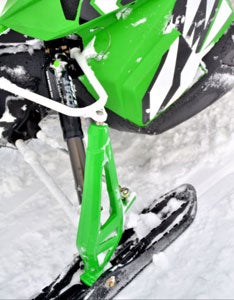 The HCR’s tall spindles with Fox shocks provide the bump soak needed to hit the rock gardens.
The HCR’s tall spindles with Fox shocks provide the bump soak needed to hit the rock gardens.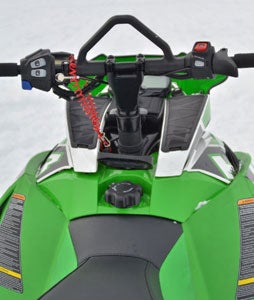 Like the M8 Sno Pro, the HCR has identical cockpit controls, including telescopic handlebars.
Like the M8 Sno Pro, the HCR has identical cockpit controls, including telescopic handlebars.The HCR has the same cockpit controls and seat as the M8 Sno Pro, giving the driver control and comfort that is needed for backcountry romps and hillclimbing stomps.
Conclusion
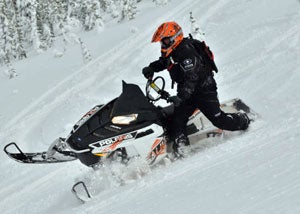 Though its ski-stance is wider than the Pro, the Assault remains flickable.
Though its ski-stance is wider than the Pro, the Assault remains flickable.These two snowmobiles are RMSHA competitors; if you as a racer choose one, you have increased your odds of winning. Additionally, these mountain snowmobiles are deep-powder bloodhounds, but have a small weakness in that their hard compound tracks make traversing over deep and light powder not as efficient as their niche-specific twins, the RMK Pro 800 and M8 Sno Pro.
The RMK Assault is lighter than the HCR by about 30-pounds. Though Cat hasn’t published a dry weight, we know this by lifting the snowmobiles during our evaluations. So weight (less of it) goes to the RMK. However, if comparing horsepower, the HCR has greater numbers, by about 10; the RMK Assault cranks out about 153 sea level brake horsepower, whereas the HCR is close to 165. With that, we feel power-to-weight for both is close. Yet, if you take into account rotating mass, the Assault fairs better. Then again, the HCR’s hard-hitting torque may upset the Assault; the Suzuki High Output twin is gutsy.
For track, the HCR wins here. The HCR’s stiff 2.6-inch Power Claw track, over the 2.125-inch paddles on the Assault’s track, works well in the powder and with its taller lugs the HCR is also a better deep-powder snowmobile, if you choose. Both use mid-150s track length.
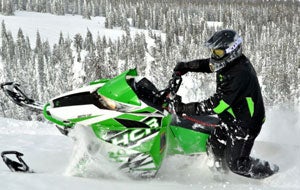 Take an HCR for walk by easing it on a side to stitch a line through the deep.
Take an HCR for walk by easing it on a side to stitch a line through the deep.The HCR has telescoping handlebars for the driver to drop the bars for awesome managed control. The Assault’s Pro Taper bars are fixed. But, you may find the Pro Taper bars are ergo correct; again, a decision you must make. For us at Snowmobile.com, we believe that dropping the HCR’s bars to their lowest position favors handling for competition use. Edge, HCR.
Seat and runningboards are comparable; however, we feel the short and rounded bun on the Assault to be more yielding for leg swing – tossing one leg over the seat to plant both feet on the boards. Assault has it here.
Looks and appeal. Tie.
Price, the Assault is cheaper by US$700.
There it is. Both snowmobiles are, well, virtually tied. The HCR’s torque-filled motor may appeal to you more. The Assault’s lesser price and lighter weight chassis may be the sugar that makes the decision sweeter.
If you were to ask the Snowmobile.com Mountain Team which of these two they would own, we would simply state…both. And that is NOT a politically correct answer, it is fact. But, we also implore you to read our article on the Ski-Doo Freeride to make a fully educated decision. The Freeride is meant to be in this hillclimb competition class.
| 2013 Arctic Cat M800 HCR | 2013 Polaris 800 RMK Assault | |
| Engine | Suzuki 794cc, two-stroke, liquid-cooled twin; 46mm dual throttle body batteryless electronic injection; Arctic Power Valve exhaust | Polaris Liberty 795cc, liquid-cooled two-stroke twin; semi-direct Cleanfire injection |
| Horsepower | 160 (Claimed) — Requires 91 octane unleaded fuel | 150-plus (Claimed) |
| Drive | Arctic 6 post rpm sensing driver with 10.75-in diameter Arctic roller cam driven | Polaris P-85 drive with TEAM LWT driven |
| Front Suspension | Arctic Race Suspension (A-arm); Fox Float EVOL shocks; up to 9.0-in travel | Pro-Ride Adjustable double A-arm with Walker Evans “needle” gas shocks; up to 10-in travel |
| Rear Suspension | M rear slide rail suspension with Tri-Hub rear axle; Fox Zero Pro gas shocks with internal floating piston on front arm; Fox Float 2 shock on rear arm; up to 15.5-in travel | RMK coil-over parallel slide rail; Walker Evans gas shock on front arm; Walker Evans “needle” gas shock on rear arm; up to 16-in travel |
| Length | 125.0 in | 129.0 in |
| Width | 48.0 in | 48.0 in |
| Height | NA | 51.0 in |
| Ski Stance | Adjustable: 42 to 43 in | Adjustable: 41.5 – 42.5 – 43.5 in |
| Track | 15 wide x 153 long Power Claw track with 2.60 lug profile | 15 wide x 155 long Competition track with 2.125 lug profile |
| Weight | NA | 435 lbs (claimed) |
| Features | ProClimb chassis; dual halogen headlight; telescoping handlebar; electronic reverse; multi-function gauge; iced scratchers; accessory outlet | Polaris electronic reverse; lightweight Cyclone disc brake; multi-function gauge; Pro Lite seat; Gripper skis; handlebar hooks |
| Fuel Capacity | 10.6 US Gal | 11.5 US Gal (Premium Fuel) |
| MSRP | $13,099 | $12,299 |
Related Reading
2013 Polaris 800 Pro-RMK 155 Review – Video
2013 Arctic Cat M800 Sno Pro Review – Video
2013 Ski-Doo Freeride Review – Video








 Your Privacy Choices
Your Privacy Choices